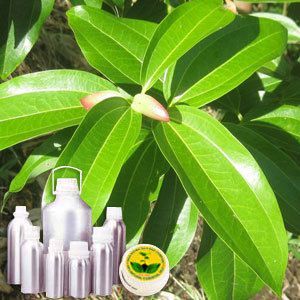Botonical Name | : | Cinnamomum Zeylanicum | |
CAS # | : | 8015-91-6 | |
Country of Origin | : | India & Sri Lanka | |
Color & Odor | : | Yellowish to brownish liquid with Spicy, warm cinnamon odour | |
Solubility | : | Insoluble in water, soluble in alcohol and oils | |
F.E.M.A. # | : | 2292 | |
Specific Gravity | : | 1.0390 - 1.0490 @ 20oC | |
Optical Rotation | : | -1.5o to + 2.5o | |
Refractive Index | : | 1.5220 - 1.5350 @ 20oC | |
Flash Point | : | >100oC | |
Major Constituents | : | Eugenol , Linalool | |
Plant Part Used | : | Leaves | |
Extraction Method | : | Steam Distillation |
DESCRIPTION:
Cinnamon oil is an evergreen native to India, Sri Lanka and Vietnam that has since been cultivated in many other regions. It has shiny, leathery green leaves, and small, white flowers with oval shaped purple berries. CONSTITUENTS:
Eugenol, cinnamaldehyde, benzyl benzoate, linalol, Alpha Pinene, Alpha-Phellandrene. AROMATIC SUMMARY / NOTE / STRENGTH OF AROMA:
A middle note of medium aroma, it has a warm, spicy scent between that of clove and cinnamon, but with herbaceous notes that are not sweet. BLENDS WITH:
Frankincense, Lavender, Cedarwood, Orange, Lemon, Neroli, Ylang-ylang. COMMON NAMES:
Cinnamomum cassia, cassia, cinnamon bark, cinnamon . USES:
Some material indicates that Cinnamon Essential Oil is perfect in topical applications, and with its pleasant scent, a perfect additive to creams, lotions, and soaps. Cinnamon Essential Oil is highly respected as having antiseptic properties. 


































